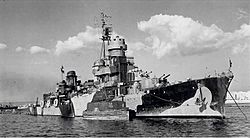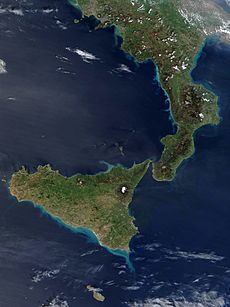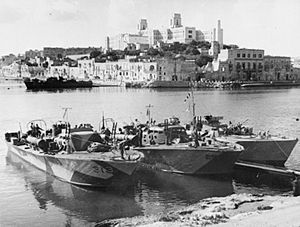Operation Scylla facts for kids
Quick facts for kids Operation Scylla |
|||||||
|---|---|---|---|---|---|---|---|
| Part of the Battle of the Mediterranean of the Second World War | |||||||
 Italian light cruiser Scipione Africano at Taranto |
|||||||
|
|||||||
| Belligerents | |||||||
| Commanders and leaders | |||||||
| Strength | |||||||
| 4 Motor Torpedo Boats | 1 light cruiser | ||||||
| Casualties and losses | |||||||
| 12 killed 1 MTB sunk 2 MTBs damaged |
2 wounded 1 light cruiser superficially damaged |
||||||
Operation Scylla (which means Operazione Scilla in Italian) was a special trip made by an Italian warship during the Second World War. On the night of July 17-18, 1943, the Italian Royal Navy's light cruiser Scipione Africano sailed from La Spezia to Taranto. This journey happened while the Allies were invading Sicily.
During its trip through the Strait of Messina, the Scipione Africano fought a night battle. It faced four British motor torpedo boats (MTBs). The cruiser used its main and smaller guns while moving very fast. One British MTB was destroyed, and two others were damaged. The Scipione Africano itself got only minor damage. This battle was special because it was the only time an Italian warship successfully used its radar during a fight in the war.
Contents
Background to the Battle
Allies Blockade Sicily
During the Allied invasion of Sicily, which was called Operation Husky, British Motor Torpedo Boats (MTBs) and Motor Gun Boats played an important role. These small, fast boats moved from Algeria to Malta. Then they went to ports in Sicily that the Allies had captured.
These boats patrolled the Strait of Messina. This is a narrow waterway between Sicily and mainland Italy. They waited in ambush for Axis ships and landing craft. The crews would turn off their engines and listen for enemy ships. Lieutenant Dennis Jermain led four boats of the 10th MTB Flotilla. He planned that one boat would act as a noisy distraction. This would allow the other boats to sneak into position and fire their torpedoes.
The Scipione Africano Cruiser
The Italian light cruiser Scipione Africano was a new and fast warship. It was one of four ships of its kind. This cruiser had a special Italian-made radar system called Gufo (which means Owl). Gufo radars had started being used in early 1942.
The Scipione Africano was based in La Spezia, a city on the north-western coast of Italy. When the Allies began their invasion of Sicily, the Italian Royal Navy knew the Strait of Messina might be blocked. So, they ordered the Scipione Africano, led by Captain Ernesto Pellegrini, to sail to Taranto. This was to make sure there were fast cruisers available in the Ionian Sea.
Getting Ready for the Fight
Operation Scylla Begins
On July 15, 1943, the Scipione left La Spezia and arrived in Naples that evening. A British seaplane watched it. In Naples, the Scipione picked up a team to help with air communication and a special device to detect enemy radar.
The cruiser sailed again on July 16 and entered the Messina straits just after midnight on July 17. A full moon was rising, making it quite bright. A few days earlier, on July 12-13, a British motor torpedo boat had sunk a German submarine in the northern part of the straits.
The Night Battle
As the Scipione entered the straits, its Gufo radar detected four small ships. They were about 10 kilometers (6 miles) ahead, between Reggio di Calabria and Cape Pellaro. At first, Captain Pellegrini thought they were friendly German motor barges.
But at 2:13 AM, the way the leading ship moved convinced Pellegrini they were British MTBs. He immediately ordered the cruiser to speed up from 24 knots (44 km/h or 28 mph) to 30 knots (56 km/h or 35 mph).
The British MTBs were four boats from the 10th MTB Flotilla, led by Lieutenant Dennis Jermain. They were waiting for Axis landing craft and German E-boats. Jermain, on MTB 315, later wrote:
I was caught completely napping. We were lying with engines stopped two miles south of Messina, in a flat calm with a full moon silhouetting us nicely. (...) We never dreamed that a cruiser will be able to get down there unseen through our patrols.
Jermain quickly gave the alarm and told his boats to start their engines and spread out. He moved MTB 315 to the east to act as a decoy. This would draw the cruiser's attention, giving the other boats a better chance to attack.

Captain Pellegrini turned his ship towards a spot between MTB 313 and MTB 316. The cruiser's high speed surprised the British. By the time they were ready to fire torpedoes, the Scipione was only about 1,500 yards (1,370 meters) away.
The Scipione opened fire with all its guns. Captain Pellegrini was amazed by how accurate the shots were. The Italian report says the fight lasted only about three minutes. The first Allied boat hit was MTB 313, which was closest to the cruiser. It was left in a "sinking condition" and was only about 300 yards (274 meters) from the Scipione. MTB 313 was about to launch torpedoes when its commander, Foster, was wounded. Another officer, Sub-Lieutenant John McKim, was seriously injured. One torpedo from MTB 313 passed just in front of the Scipione, and the damaged MTB managed to limp away.
MTB 260 was also on the cruiser's starboard side. It claimed to have hit the Scipione. After being fired upon, MTB 260 escaped with minor damage. The Italian report said it caught fire. MTB 316 was about 50 yards (46 meters) from the Scipione when it was hit. The MTB caught fire and exploded within seconds, sinking with all its crew. The explosion was so close that pieces of MTB 316 fell onto the Scipione.
MTB 315 and MTB 260 chased the Scipione down the strait until the cruiser turned towards Taranto. Captain Pellegrini reported that one of the boats on the port side fired two torpedoes, which the Scipione avoided. This was MTB 315, which the Scipione then attacked with its heavy machine guns.
At the end of the battle, the Scipione was accidentally fired upon by German and Italian coastal artillery. This caused minor damage and wounded two sailors. British sources also mentioned an air attack on the Scipione by Axis planes, but Pellegrini did not report this. The Scipione reached Taranto at 9:46 AM on July 18.
After the Battle
Later Operations
About an hour after the Scipione passed through the straits, another Italian submarine, the Ambra, arrived at Messina. It was escorted by the torpedo boat Partenope. The Ambra was supposed to attack Allied ships at Syracuse but the mission was canceled. The submarine was attacked by a British plane and damaged, but no one was hurt. It returned to Messina.
The morning after the battle, Sub-Lieutenant McKim, who was seriously injured on MTB 313, was buried at sea. No trace of MTB 316 or its crew was ever found by Allied forces. The Scipione later helped lay defensive minefields in the Gulf of Taranto and the Gulf of Squillace. After Italy surrendered, the Scipione escorted the Italian royal family to safety. It then took the new head of government, General Pietro Badoglio, and his team to Malta.
See also
- Gufo radar


